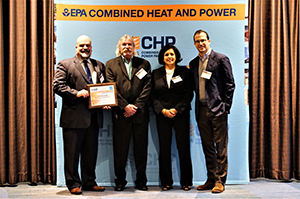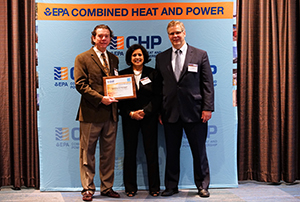Energy Star CHP Award Winners
Winners of the 2016 Energy Star CHP Award
Announced December 7, 2016
Our 2016 award winners demonstrate how CHP can save money and reduce pollution — a real win-win for the bottom line and the environment. Onsite power generation, like CHP, can also strengthen our nation’s electrical infrastructure.
Three of the award-winning CHP systems are located at medical centers where energy efficiency is a key strategy to control the cost of health care. The fourth award-winning system is located at an Army National Guard facility where mission support helicopters are housed and maintained.
- Maine Army National Guard — Bangor, Maine
- South Oaks Hospital — Amityville, New York
- University of Maryland Upper Chesapeake Medical Center — Bel Air, Maryland
- University of Massachusetts Medical School, Worcester Campus — Worcester, Massachusetts
Maine Army National Guard — Bangor, Maine
 Charged with the mission of providing rescue, MEDEVAC and security support operations throughout Maine and New England, the Maine Army National Guard operates the Aviation Support Facility (AASF) in Bangor, Maine.
Charged with the mission of providing rescue, MEDEVAC and security support operations throughout Maine and New England, the Maine Army National Guard operates the Aviation Support Facility (AASF) in Bangor, Maine.
The facility’s CHP system, designed by Innovative Construction and Design Solutions, includes a natural gas-fired Aegis Energy Services internal combustion engine generator that produces up to 75 kW of electricity. Heat from the engine--which would otherwise be wasted--is recovered and used to produce hot water to radiantly heat the facility’s hangar, maintaining the operational readiness of the aircraft in a region with over 5,000 heating degree days.
With an efficiency of 73 percent, the system requires approximately 32 percent less fuel than would be used by conventional production of electricity and hot water. An estimated 100 tons of carbon dioxide emissions are avoided annually, equal to the emissions from the generation of electricity used by more than 14 homes. A 40 kW photovoltaic panel further reduces energy costs and carbon emissions.
In 2016, Secretary of the Army Eric Fanning issued a challenge for the U.S. Army to commission 50 megawatts of new CHP each year over the next four years. The Army anticipates that the award-winning Bangor system could serve as a model for the approximately 500 Army aviation and ground vehicle support facilities across the U.S. with energy characteristics similar to AASF’s.
South Oaks Hospital — Amityville, New York
 The award-winning CHP system at South Oaks Hospital, a 400-bed facility in Amityville, New York, includes five natural gas-fired internal combustion engines powering 250 kW synchronous generators supplied by IntelliGen Power Systems. Heat from the engines’ exhaust and cooling systems (which would otherwise be wasted) provides space heating and hot water for the hospital, and also powers an absorption chiller to provide air conditioning.
The award-winning CHP system at South Oaks Hospital, a 400-bed facility in Amityville, New York, includes five natural gas-fired internal combustion engines powering 250 kW synchronous generators supplied by IntelliGen Power Systems. Heat from the engines’ exhaust and cooling systems (which would otherwise be wasted) provides space heating and hot water for the hospital, and also powers an absorption chiller to provide air conditioning.
In the aftermath of Hurricane Sandy, when the area lost grid-supplied power for 14 days, the South Oaks CHP system continued to supply electricity during the outage, enabling the hospital to continue normal operations as well as provide emergency services to the nearby community.
With an efficiency of 70 percent, the system requires approximately 29 percent less fuel than would be used by conventional separate electricity and steam production, saving nearly $900,000 annually. An estimated 2,600 tons of carbon dioxide emissions are avoided annually, equal to the emissions from the generation of electricity used by more than 350 homes. A 47 kW solar photovoltaic system further reduces energy costs and emissions.
University of Maryland Upper Chesapeake Medical Center — Bel Air, Maryland
 Located in Bel Air, Maryland, the Upper Chesapeake Medical Center (UCMC) serves the local community by annually providing emergency care to 4,200 patients and performing 730 surgical procedures.
Located in Bel Air, Maryland, the Upper Chesapeake Medical Center (UCMC) serves the local community by annually providing emergency care to 4,200 patients and performing 730 surgical procedures.
UCMC’s CHP system–designed by TMR Engineering and owned by CFSG Energy & Structured Finance–includes a 2 MW Caterpillar natural gas-fired internal combustion engine and a 350-ton Broad USA absorption chiller. Heat recovered from the engine—which would otherwise be wasted—provides space heating and hot water, and powers the absorption chiller for air conditioning.
Motivated by the desire to improve patient care, UCMC chose CHP to achieve three goals: decrease operating costs, enable continued operations when grid-supplied electricity is not available, and reduce the facility’s carbon footprint.
With an operating efficiency of 75 percent, the system requires approximately 34 percent less fuel than would be used by conventional electricity and steam production, and also avoids emissions of air pollutants, including an estimated 4,700 tons of carbon dioxide annually (equal to the emissions from the generation of electricity used by more than 630 homes). The system saves the University an estimated $300,000 each year. Moreover, generating electricity on site reduces demands on the region’s transmission and distribution infrastructure.
University of Massachusetts Medical School, Worcester Campus — Worcester, Massachusetts
 Recognizing the importance of highly efficient and resilient energy production, the UMass Medical School (UMMS) relies on CHP to help power its Worcester, Massachusetts campus, which hosts over 7,300 employees and 2,900 visitors daily. This Energy Star CHP Award recognizes UMMS’s third and most recent CHP expansion: the addition of a 7.5 MW natural gas-fired Solar Turbines combustion turbine generator, with the assistance of Waldron Engineering & Construction.
Recognizing the importance of highly efficient and resilient energy production, the UMass Medical School (UMMS) relies on CHP to help power its Worcester, Massachusetts campus, which hosts over 7,300 employees and 2,900 visitors daily. This Energy Star CHP Award recognizes UMMS’s third and most recent CHP expansion: the addition of a 7.5 MW natural gas-fired Solar Turbines combustion turbine generator, with the assistance of Waldron Engineering & Construction.
With an efficiency of 73 percent, the new CHP unit requires approximately 20 percent less fuel than conventional separate electricity and steam production. The reduced fuel use avoids emissions of more than 21,000 tons of carbon dioxide annually, equal to the emissions from the generation of electricity used by more than 2,800 homes. Moreover, by generating electricity on site, the system strengthens the regional transmission and distribution infrastructure.
The expanded power plant generates up to 90% of the campus’s electricity needs. Because the plant’s electrical output is responsible for less carbon pollution than grid-supplied electricity, the facility receives substantial payments through Massachusetts’ Alternative Portfolio Standard program with the assistance of their representative, Green Harbor Energy. The plant reduces the facility’s cost of energy services by approximately $3 million annually.
